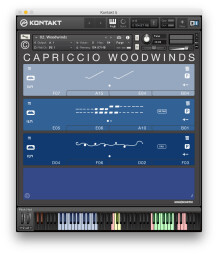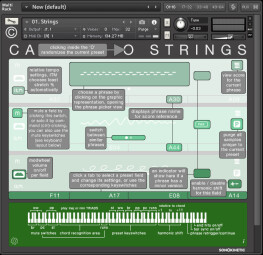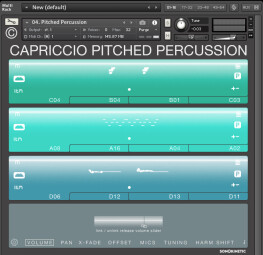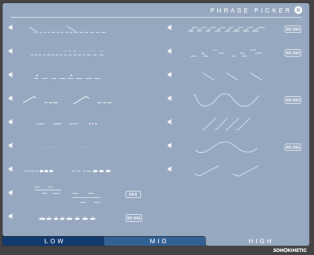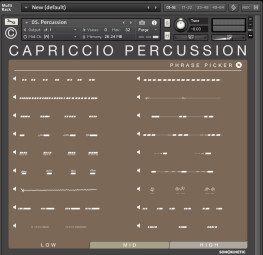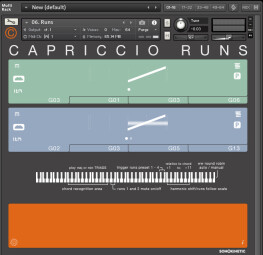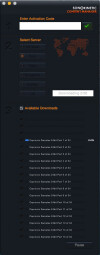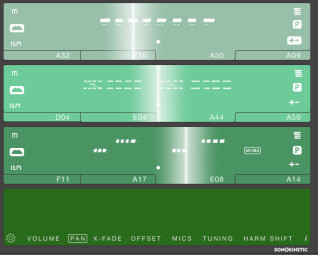The supply of virtual orchestras has become more and more abundant. There's a seemingly never-ending rise in the number of samples, instruments and content available, in general. But what about how they're used? Sonokinetic has come up with a unique answer with Capriccio.
If you consider the history of virtual orchestras based on recordings (not on synthesis), the first attempts were made using two different approaches. The first involved the extensive sampling of orchestral instruments, as done by pioneers Miroslav Vitous (the first to offer a complete library in 1992) and Peter Siedlaczek (with the Orchestra Library, launched the same year). The second approach incorporated the use of “building blocks” to create layers with phrase kits, as Siedlaczek did with his Orchestral Colours in 1995. This method would soon be adopted by all sample library producers, from EastWest to Best Service to Zero-G and so forth.
Multi-sampled instruments have become increasingly easy to use and realistic, thanks to a variety of factors. These include the number of articulations provided, the scripts developed for compatible platforms (especially Kontakt, predominantly used by orchestral library producers), and the development of specially conceived instruments (most notably those provided by VSL, which are certainly today’s most effective ones). But even if you can find solutions to phrasing issues related to multi-sampling (see: the Orchestral String Runs by Orchestral Tools, a real game-changer for string lines), more often than not, a phrase played by a real musician or a complete section will sound better than one assembled with multi-samples, regardless of the quality of the multi-samples or the competency of the composer/musician/programmer.
|
As such, certain library producers prefer to offer their clients a solution based on phrases to be layered, similar to those seen in the first audio libraries on CD. Back then, those libraries made users’ workflows much easier, because they no longer needed to import phrases into their samplers, edit them, transpose them, adjust them, slow them down or speed them up, all while using what was, at the time, considered to be a ridiculous amount of RAM (lots of RAM back then meant at least 16… MB!). Today, dedicated tools have reached unbelievable levels of quality regarding overall performance, both in terms of transposition and time expansion/compression. Depending on the software and algorithms, you can actually get credible transpositions as large as a fifth, and vary the tempo by up to about 33% (you can go even further, obviously, but the effects are audible; we actually made a comparison several years ago, and while it may be old, it details the possibilities of the main tools available at the time).
These possibilities are obviously worthless without a good foundation, in other words, the orchestra, itself. Thus, we have Native Instruments and its Action Strings or Action Strikes, 8DIO’s Solo Violin, and many library producers, from Project Sam to Spitfire Audio, that include ready-to-use phrases in their products. But after several years, Sonokinetic has become the main specialist on the subject with a unique approach that is as musical as it is user-friendly. The latest product of the company goes by the name Capriccio. Let’s look into the details.
Introducing Sonokinetic Capriccio
The library is available on Sonokinetic’s site for €300 (not including VAT), and can also be ordered on a USB key. It offers more than 38,000 samples per version (16– or 24-bit) for a total size of 18.4 GB or 34.8 GB, respectively, once the audio files have been uncompressed. (Sonokinetic, like almost all producers using Kontakt, has adopted the NCW compression format created by Native Instruments.) The download is done in parts, facilitated by Sonokinetic’s Content Manager, which allows you to choose, stop and pause which elements you’d like to download (16 or 24 bit, for example). Depending on your network connection speed, you’d better plan for another activity while it finishes downloading.
Once all .rar files have been downloaded, you have to use a compatible software tool to extract everything into a single folder: Instruments, documentation (comprehensive, including videos), samples, etc. Like many other Sonokinetics products, you can separately buy the orchestra conductor for all phrases in the form of a password-protected PDF, for €49.90 (186 pages in A3 format…).
The authorization procedure is business as usual: you add the Library and then submit the serial number to the Service Center. In terms of compatibility, Capriccio depends on Kontakt, obviously, but Sonokinetic allows the use of the library with Kontakt and Kontakt Player (free) from version 5.1.
On a whim
The library is the largest one ever proposed by Sonokinetic. The principle is the same used on previous products. Specifically, the instruments are split into sections (Strings, Brass, Woodwinds, Percussion, Runs, and Multisampled Percussion Ensemble), in full or light versions. The orchestra is of a respectable size, 87 musicians in total, and was recorded in the same room as all other Sonokinetic symphony libraries. It offers four different microphone options: Close, Decca Tree, Wide, Balcony (far), plus a Lite version, which is a Tutti mix of the four.
All phrases were recorded at 130 BPM, with a single time signature (4/4), in eighth and sixteenth notes, and then reunited under one of the three instrument sections (called “fields” by the producer): Low, Mid and High. You shouldn’t go looking for phrases specifically played by the first violins or the clarinets (even if they might exist), but rather for ensembles made up of different elements of the section, classified according to their place in the audio/musical spectrum. This principle has its obvious advantages, like the coherent distribution of instruments, but also has its disadvantages, namely the impossibility to include certain instruments. For example, the Strings program does not systematically provide phrases played by the cellos or the altos, nor can it layer two distinct parts played simultaneously by the first and second violins; instead, the orchestral mass is actually doubled.
Most of the actions are triggered with the keyboard, including the phrases with major or minor triads (no other chord is recognized), the four pre-loaded variations, the mutes, retriggering of the phrases, runs, harmonic shift, and activation of release samples via dedicated keys.
Regarding the project, we must admit that the user-friendliness is remarkable. Each Instrument part features a Mute button (which works great from the keyboard, although it doesn’t have a real-time effect when engaged via the interface), a button to activate the action of the wheel on the volume (hence you can boost one or two parts during an ostinato, for instance, which is pretty nice). Here’s an example of the latter, first with four bars as-is, then with a volume boost on the upper voices:

You also get a button for the ITM function, which applies intelligent playing modifications according to the tempo. The idea is not to end up with eighth notes when going from 130 BPM to 80 BPM, but rather to apply a more “musical” transformation into sixteenth notes, for example. Once deactivated, you can modify the tempo independently (x1, x2, x1/2).
On the right you can activate/deactivate the Harmonic Shift, which allows you to transpose the phrases on each of the Fields in order to modify the harmonies produced. In our example below, we start with four bars using the ensemble created when selecting the phrase, and then modify the upper voice with Harmonic Shift (with the dedicated octave).

A setting hidden in the Options allows you to define the desired interval via a matrix. A very well-implemented and perfectly functional feature. Hats off!
Options and phrases
The Options include an entire array of additional controls, especially in terms of Volume, Pan, Offset (these first three with a beautiful system of luminous lines), Crossfade, and Tuning. Additionally, there’s a slider to adjust the microphone mix and the possibility to choose between two different positions.
Sonokinetic created a very simple phrase-selection system ─ the Phrase Picker ─ that allows you to give yourself an idea of the type of phrase you are dealing with, thanks to a very telling graphical representation, which you can obviously complement with a listening preview, but also with the score view. The MI/MA indication allows you to load a phrase that corresponds to a minor or major triad, since they include a third. Most other phrases (except for melodies and Runs) are based on octaves and fifths, and don’t add any coloring to the layer.
If you find yourself with the following type of phrase, for instance:

you only need to load one of the Fields with a similar phrase, but with a third, to go from minor to major and vice versa. Or, you can use the Harmonic Shift function if you want to retain the exact same rhythmic elements, knowing that you can switch from one to the other during playback/play.

Each Field has roughly 18 sufficiently varied categories, which allow you to make lots of combinations, considering that you can open as many Kontakt instances as you wish, and only take bits from one or the other. You can thus make a quick draft of a composition with phrases close enough to those composed (but be careful, they are mostly rhythmic elements, the melodies ought to be played/programmed with other instruments from other libraries).
Sonokinetic also offers beautiful percussion instruments in the form of phrases or multi-samples, along with a patch for Runs, which works like the rest of the library: a triad, a motif selection and Harmonic Shift. Here are some examples:

To give yourself an idea of the overall sound, below is a simple assembly of all instruments (without Runs or multi-sampled percussion):

Conclusion
From a technical point of view, i.e. evaluating the possibility to have authentic phrases (essentially rhythmic ones, mind you) played by an orchestra with unrestricted access to the tempo, diverse and varied layerings and reharmonization possibilities, the mission has been accomplished! Furthermore, the library is one of the most user-friendly out there. However, you will need to play or program the chord and rhythm changes carefully, etc.
Capriccio will allow for quality productions, if you are aware of its limitations. Specifically, it will be hard to compose using complex time signatures. And to create real melodies (it’s better suited for ambiances or to give support to solo instruments), you won’t necessarily find all your desired rhythm/figures, nor huge transposition or time-compression/expansion possibilities. From a strictly orchestral point of view, you won’t be able to avoid effects caused by the layering of sections, which artificially increases the number of musicians, just as you wouldn’t be able to avoid writing “mistakes.”
All that considered, it’s a real pleasure to play and program the instrument, which is definitely one of Sonokinetic’s best achievements to date. And that’s why we’ve provided it with the Best Product Award for 2015. Well done guys, keep it up!


